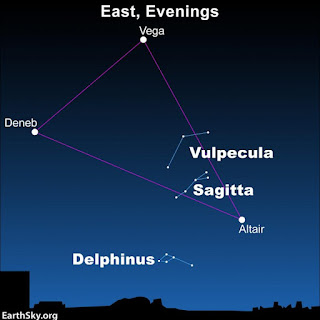Velpecula & Sagitta
Vulpecula constellation lies in the northern sky. Its name means “the little fox” in Latin. It is not associated with any myths.
The constellation is a relatively faint one, with no stars brighter than fourth magnitude. It lies in the middle of the Summer Triangle.
Vulpecula was introduced by the Polish astronomer Johannes Hevelius in the late 17th century.
Hevelius originally named the constellation Vulpecula cum ansere which means the little fox with the goose.
The constellation was depicted as a fox holding a goose in its jaws.
The stars were later separated to form two constellations, Anser and Vulpecula, and then merged back together into the present-day Vulpecula constellation.
The goose was left out of the constellation’s name, but instead the brightest star, Alpha Vulpeculae, carries the name Anser which is Latin for “Goose.”
Sagitta myth
Sagitta constellation is usually associated with the arrow that Hercules used to strike down the eagle that Zeus sent to bit Prometheus’ liver.
In mythology, Prometheus moulded men and women out of clay in gods’ likeness, and gave them fire that he had stolen from the gods.
Zeus decided to punish him for this, and chained him to Mount Caucasus, where the eagle perpetually bit his liver, which would always grow again at night.
The eagle is represented by the neighbouring constellation Aquila.
Hercules found Prometheus during one of his journeys, struck the eagle down with an arrow, and freed Prometheus.
Next will see the small dolphin.
Till then good bye.
Keep commenting.






👌👌
ReplyDelete